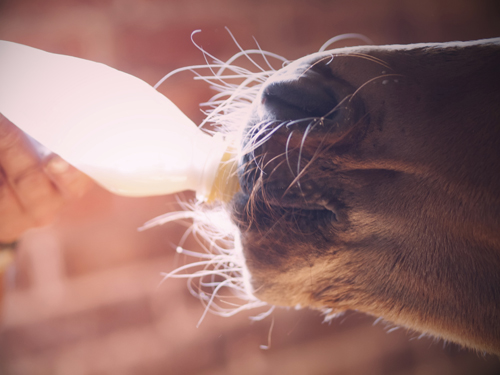
feeding of little foal from bottle
Breeding is not for the faint of heart. And nothing quite drives home that message as strongly as the prospect of raising an orphan foal. It’s heartbreaking. It’s challenging. It’s confusing. Do you try to locate a nurse mare? Would bottle feeding work? What about socialization? We talked to several breeders who have either raised orphan foals in the past or are dealing with the challenge now. The offer some sound advice on navigating this critical development period.
It was the middle of the night when Marion Beachy stumbled upon trouble.
As the owner of Abby Stables, a full-service breeding and boarding facility in Sugar Creek, Ohio, he was conducting his nightly walk through the barn to check to make sure everything was in order.
Everything was not.
Beachy found one of his residents, Priscilla, an overdue recipient mare, in trouble. She was cast, colicky and in severe pain. He jumped into action.
First Beachy treated the mare for colic and then he loaded her into the trailer he always keeps hooked up in case of an emergency.
On the way to Valley View Animal Hospital in Dover, Ohio, Beachy called Liz Flohr to bring her up to speed. Priscilla was carrying an American Quarter Horse Association (AQHA) embryo foal, by Both Guns Loaded and out of Sleepinwithmybootson, owned by Flohr and Ann Taylor.
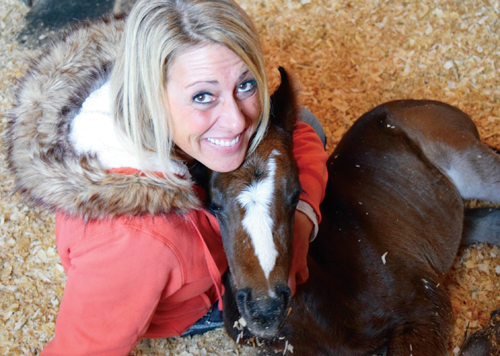
Liz Flohr and Elroy
Dr. Curt Honecker knew right away the situation was not good. He performed an emergency C-section to deliver a big, bay colt that would be nicknamed Elroy but Priscilla would not survive.
“It happened so fast,” Flohr explained. “It’s just a miracle that we have the foal. We are so grateful for both Marion Beachy and Dr. Curt Honecker for all they did because without them we would not have Elroy.”
Since Elroy was brought into the world via C-section, he was never introduced to his mother. He was first immediately bottle then bucket fed.
“We were so grateful to have the foal but then it hit us what do we do now?” Flohr said. “The next day we decided to try him on a recipient mare that we had who recently delivered a foal but she did not accept him. We then tried a second recipient mare who was Ok with Elroy but he was not Ok with nursing.”
It seems even though Elroy was a 100 percent normal foal, he had never been introduced to his mom at all and had been drinking from a bucket long enough at this point that he was really fumbling with the nursing process.
In this particular case, Dr. Honecker felt like going with the buddy system was a better route for Elroy.
“Orphan babies are a difficult proposition if the end goal is to raise a show horse,” he said. “There are many advantages to having a nurse mare so the orphans don’t turn into pets but nurse mares can sometimes be a difficult situation because the orphans are not always accepted. I have had to leave mares tied, hobbled, blindfolded etc. in order to let babies nurse and even then it doesn’t always work. So it’s really a toss up between having your baby raised by a mean horse or no horse which down the road can lead you to having a horse that is either scared of everything or scared of nothing.”
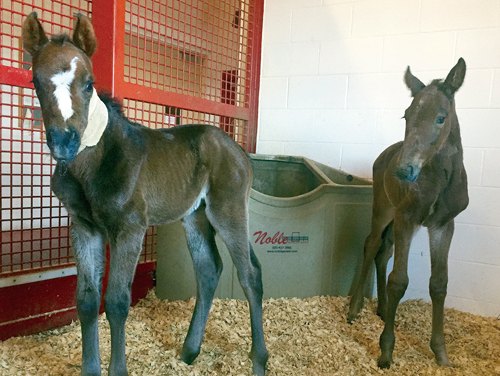
Elroy currently lives with Vanessa, a Standardbred filly who also lost her mother.
Elroy’s story took a different turn.
As fate would have it, rose run, a nearby Standardbred farm, had an orphaned filly too. Her name was Vanessa.
Vanessa had been introduced to her mom for a short period of time before her the mare ruptured and had to be euthanized. Vanessa was introduced to another mare who had recently delivered her own foal. Although she did accept Vanessa, the mare was havingtrouble producing enough milk for two foals.
It was then that Vanessa was introduced to Elroy.
“Vanessa and Elroy met and instantly became friends,” Flohr explained. “They play and wrestle. It was by far the best thing we could have done. I can see though how if you are not careful with an orphan foal they can become little monsters. They are so cute but they are fearless because they did not have a mom to set any boundaries for them. Having the other foal has really provided a normalcy for both of them.”
Dr. Honecker agrees and is very pleased with the progress of both Elroy and Vanessa.
“The buddy system also works much better in a case like with Liz where the orphans are raised by a horse trainer,” he explained. “To become functional adult horses it is very important the foal knows its boundaries.”
The recommended feeding for orphans according to Dr. Honecker is a milk replacer in bucket twice a day and milk pellets at three to four days old. At about a month he recommends to start weaning the babies off the milk replacer and changing to water gradually and to also start mixing pellets with sweet feed.
 “Always buy a high quality milk replacer that is just formulated for horses,” Dr Honecker said. “Many of the major companies like Progressive, Purina, Land O Lakes for instance make good ones. Whichever kind you choose, it is important to stick with the same kind and not switch products through the process.”
“Always buy a high quality milk replacer that is just formulated for horses,” Dr Honecker said. “Many of the major companies like Progressive, Purina, Land O Lakes for instance make good ones. Whichever kind you choose, it is important to stick with the same kind and not switch products through the process.”
Now a little over a month old, both orphans are residing at Recchutti Show Horses in Heath, Ohio. They have a double stall and being in a training barn they are exposed to a lot of commotion. They go out and play together daily and are now eating free choice milk pellets, 12 gallons of milk replacer (twice a day) and free choice hay and water.
“From something that started out as a very scary situation with a nightmare beginning, it has turned into being quite easy and has a happy ending,” Flohr said. “When life changes you just have to adjust your plans!”
The foals will remain together for three to four months and then when some of her other babies are weaned, the orphans will go out with the other babies in a four to six baby herd,” according to Flohr. The babies will be able to socialize at this time and get introduced to the group together.
“I expect it will be hard to separate the two foals at first so at four months our plan was to let them make some new friends in a group and then take the race baby away from the group and put her with another group but I don’t recommend doing it all at the same time,” Dr Honecker said.
The seasoned veterinarian works with a large number of horses so it just follows that he encounters a few orphans each year.
“It really depends on your circumstance and what comes up as to what is best route to take,” he suggested. “Another option is forcing an open mare to lactate but the drawback with this is that it takes seven to 10 days for a mare to come to her milk. I have one farm that keeps an old recipient mare who was a great mother just around for that reason.”
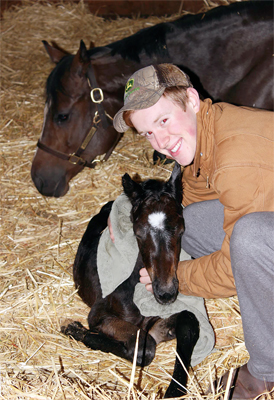
Jimmy is pictured with Tracie’s son, James
A seasoned breeder of over 20 years, Tracie Plummer of North Plains, Oregon, has seen a little bit of everything. Yet, none of her prior experiences could have prepared her for her first orphan foal this year.
Plummer’s most prized broodmare, RL Illustrious was a producer of top show horses. Sired by A Sudden Impulse, she was out of Sexy Investment (by Principal Investment) and was due on Feb. 14.
She was carrying a Battman foal and Plummer could not wait for the foal to arrive.
Although the foaling seemed at first to be normal, Plummer became concerned when her mare was slow to get up. After she did, her placenta looked unusually thick and it was then Plummer said, she knew something was wrong. It was time to contact the veterinarian.
As it turned out, Plummer’s mare had torn her uterus. Tracie was able to milk her colostrum before the mare had to euthanized. Her new colt, nicknamed Jimmy, was an orphan.
“It was 2 a.m. on a Friday,” she recalled. “What do you do? We did not have any milk replacer on hand and all the stores were closed. I also don’t live in an area that has many neighboring breeders. So, my husband went out was able to find goat’s milk. We tubed the colostrum, did plasma and then bottle fed him goat’s milk before teaching him to drink out of a bucket. He took right to it and has really been a trooper.”
“He would only drink the milk replacer at certain temperatures so I started sleeping in the barn lounge to feed him every two hours,” she said.
Plummer’s veterinarian was able to locate a nurse mare in Washington who had had a very late foal the prior year. The mare still had a 6- month-old colt at her side and enough milk. She was known to be a very good mother and sweet mare so Plummer thought it was worth a try.
“Everyone I talked to advised me that I would know immediately if she would take the foal,” Plummer said. “We tried all the normal tricks like blindfolding, Vicks in the nose, and the whole experience was an epic fail. I really think she would have killed my foal if we had kept at it. There was no way she was accepting him.”
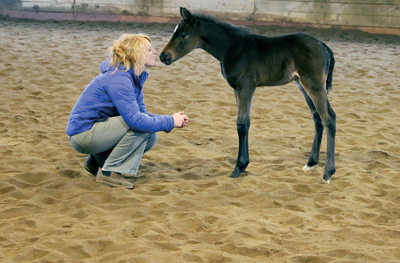
Tracie Plummer is having her first experience raising an orphan foal this year.
A few days later, Plummer was talking to her friend, American Paint Horse Association (APHA) breeder, Angela Teufel-Finegan, who lives nearby. She was telling her friend about everything she had tried, when Teufel-Finegan offered the service one of her older mares. This mare had delivered several foals over the years and was known to be a good mother. It took about 10 days before the mare started to lactate and although she was not mean to the foal, at that point Jimmy had been bucket fed for so long that he did not take to nursing off the mare.
“The whole process was extremely stressful,” Plummer admitted. “I lost my mare and now everything I was trying to do right by the foal was not working the way I had hoped.”
At that point, Plummer just decided to give up on getting Jimmy to nurse off a mare. He was doing great on the milk replacement and was very healthy. Instead Plummer decided to pair Jimmy with her 18-year-old pony, Sully.
“The hardest part of this process has been not having a playmate. I decided to introduce him to the pony and see how that would go,” she explained. “Sully put him right in his place and they became instant friends. Sully is now showing Jimmy the ways of the world and at this point I feel really good about how it is going.”
Although Jimmy has been an easy colt to halter break and work around, Plummer says she now has a new appreciation for her mares and all they really do for the babies. She plans to put Jimmy out with her other foals eventually.
“Even though I hope to never have to go through this experience again, I did get quite the education,” she said. “I am pretty happy with the direction it has gone so far.”
Plummer said she thinks Jimmy is one of the nicest foals she’s ever raised and she has high hopes for his future as a show horse.
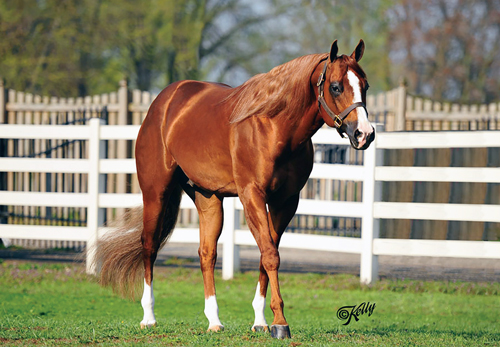
Quarter Horse Congress Champion and leading AQHA sire Too Sleepy To Zip
Quarter Horse Congress Champion and leading AQHA sire Too Sleepy To Zip is a case in point. The 2000 sorrel stallion who now stands at the same place he was born, BSB Quarter Horses in Sturgis, Michigan, owned by Shelley Donovan, Kim Rotenberry and Hedy Levin was an orphan himself.
Sired by Zippo Jack Bar, Too Sleepy To Zip’s dam, To Sleepy Too, died in delivery. Donovan said he was tubed with colostrum and then bottle fed while waiting a couple of days for his nurse mare “Ernestine Will Buck.”
“We decided then to call him Ernie as it was love at first sight for Ernestine, and the young foal,” Donovan recalled. “She was a very accommodating mare and by the end of the summer all the babies ate from Ernestine.”
Too Sleepy To Zip won the 2-Year-Old Western Pleasure at the 2002 Quarter Horse Congress and placed seventh that same year at the AQHA World Championship Show. He also earned points in Hunter Under Saddle and has sired multiple AQHA, APHA and Appaloosa Horse Club (ApHC) World Champions.
BSB Quarter Horses has had their fair share of orphan foals.
“Unfortunately when you have as many babies as we have, you will have orphans,” Donovan said. “We are not really sure how many we have had over the years. Those memories fade quickly once the baby grows up. We have raised them all different ways but for us the best by far is getting a nurse mare.”
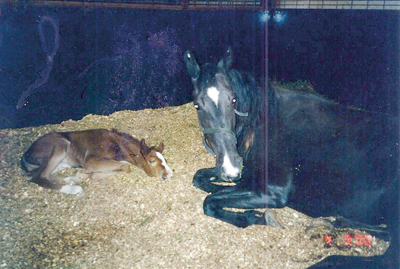
Too Sleepy To Zip with his dam, To Sleepy Too, who died giving birth.
With their vast experience, both Donovan and Rotenberry agree that having a nurse mare is best because it helps the babies grow up to be well-rounded individuals. They can then also go out with the rest of the mares and babies where they get regular socialization.
“They also learn some discipline,” Donovan said. “I’m pretty sure Ernie would have been a major spoiled child if he grew up alone!”
In cases of older foals who have lost their moms, Donovan and Rotenberry have had great luck with milk pellets. In fact one of their girls, Whoz Been Good, was raised that way.
“She grew up normal but she did and still does lack social skills of babies that have moms. Nothing bad, but just a bit of a loner,” Donovan said.
Donovan and Rotenberry said over the years, they have not had much luck trying to lactate mares and believe if the goal is to raisea show horse, a nurse mare is the best route.
“I know nurse mares aren’t feasible for everyone, be it cost or location,” Donovan said. “In those cases, you have to work on teaching bucket feeding. It usually doesn’t take long and the products available today raise good healthy babies.”


You must be logged in to post a comment Login